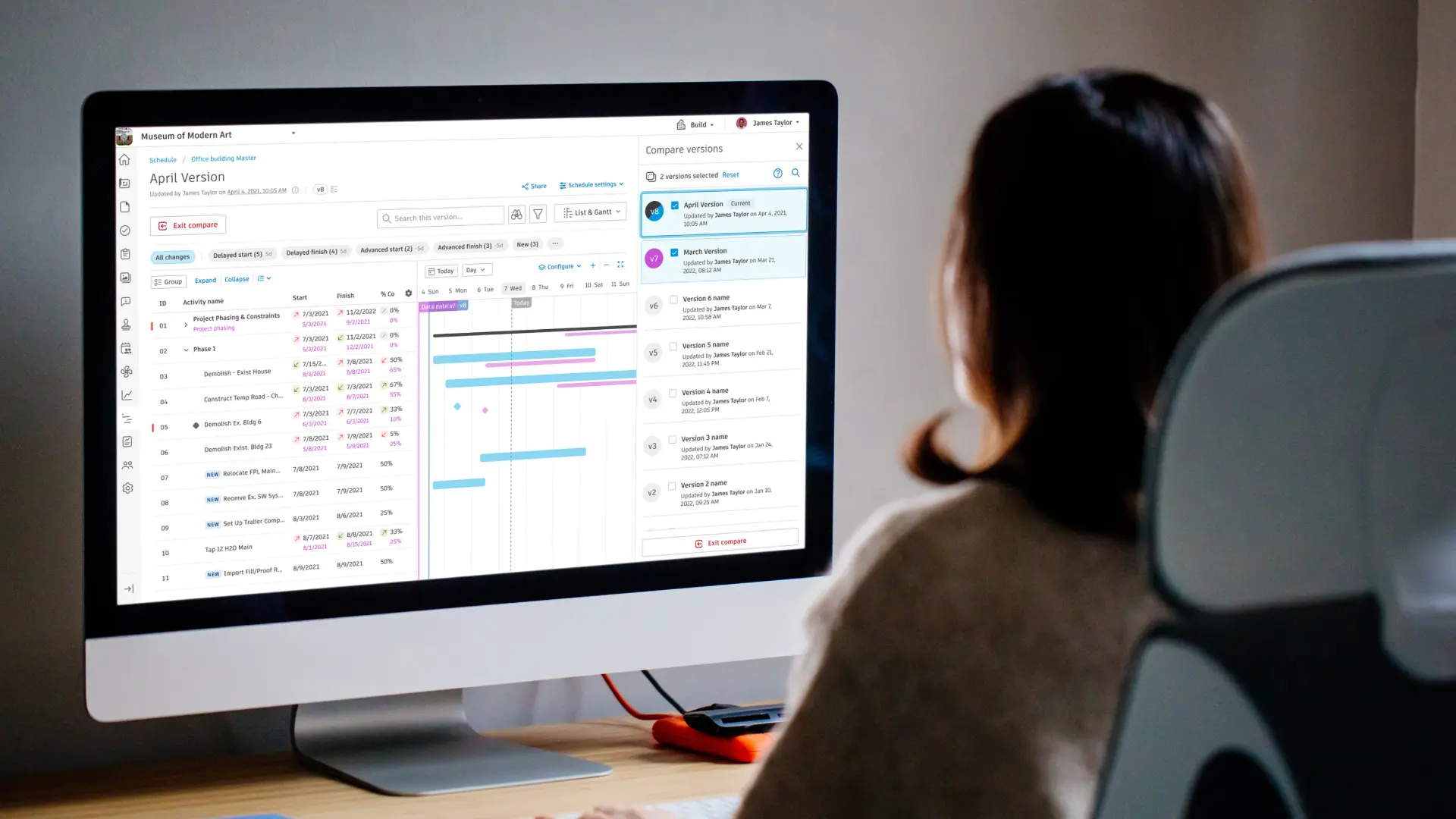Help us improve your experience. See content that is made for you!
See how IBM increased their efficiency by up to 30%!

Help us improve your experience. See content that is made for you!
See how IBM increased their efficiency by up to 30%!


The construction industry really takes the adage "time is money" to another level. With today's projects being bigger and more complex, time isn't just money—it's a small fortune. Wasted time and delays can lead to financial losses in the form of rework, increased labor costs, and even penalties or disputes.
This is why having an accurate and updated project schedule is so important. Not only does it keep teams on track, but it also allows stakeholders—i.e., GCs, subcontractors, and vendors—to coordinate and allocate resources effectively.
When everyone has access to the construction schedule, the chances of completing the project on time and within budget are much higher.
Unfortunately, most construction pros struggle to stay on top of project schedules. Research from Dodge Data & Analytics shows that 66% of general contractors carry added costs from overtime shifts on at least three-quarters of their projects due to schedule slippage.
The results of a poll we ran at our recent webinar on Autodesk's construction schedule management software align with these findings. We asked participants what percentage of their projects encountered schedule delays, and over half—52%—said they faced delays at least 50% of the time.

Scheduling is clearly a struggle for many teams, but what exactly causes delays and mishaps in construction projects?
Let's look at how most teams typically handle schedules:
Multiple stakeholders are usually involved, and schedules are created using various authoring tools such as Primavera P6, Asta Powerproject, or Microsoft Project. From there, teams print out the schedules and post them on the job trailers.
Life would be easier if the process stopped there. But as most people know, project schedules are dynamic and constantly changing. In fact, Dodge Data & Analytics found that 42% of construction professionals update their schedules on a weekly or even daily basis.
As such, printing out PDFs and distributing documents by hand simply won't cut it. Keeping everyone updated also becomes an uphill battle when handling schedules manually. Project changes can come at you fast; often, by the time you've printed out your documents and sent them to the jobsite, the schedule may have changed already.
This is where modern construction platforms come into play. While technology certainly can't solve everything, construction schedule management software streamlines the process and alleviates many of the challenges above.
The right tech gives you a single source of truth (ideally in a cloud-based environment) so teams have the latest schedule info at their fingertips. No need to rely on static documents like PDFs and email; when you equip teams with digital construction schedules, stakeholders in the office and the field can stay aligned, anticipate next steps, and collaborate more effectively.
Construction schedule management software transforms planning, executing, and managing projects. But with many options available, knowing how to make the most out of the tool (or tools) you're utilizing can be challenging.
In our recent webinar, we saw inside one construction schedule tool within Autodesk Build. You can watch our webinar here or learn more about how to maximize your schedule software by reading more below.
Construction schedule management software improves collaboration by allowing stakeholders to communicate changes or suggestions through the platform. For example, if you see something on the project, an issue or RFI for example, that may impact the project, you can raise your concerns by adding comments or suggestions to the schedule documents. Doing so helps teams better understand the project and mitigate risk.
Autodesk Build, for instance, enables you to add comments through the tool, which keeps project discussions where they belong—on the schedule itself.
Rather than email or phone calls (which may keep other stakeholders out of the loop), keeping your discussions inside the schedule management software ensures your comments are visible to the rest of the team, and everyone stays aligned.
This capability becomes even more powerful when used on mobile devices. Stakeholders get notified when changes or comments are made, and they can view the most up-to-date information right on their phone or tablet.
Watch here: 3 Ways the Schedule Tool in Autodesk Build Keeps your Projects on Track
With the correct data and insights at their fingertips, stakeholders can take action in the field, thus helping projects move along faster.
Plus, all comments and changes are logged into the platform, so someone like a superintendent or a project manager is able to always reference those changes throughout the project.
Scheduling issues occur not because numerous stakeholders are involved in a project—that's just a given in construction. Mishaps arise when team members can't get the information they need to make timely, data-driven decisions.
One way to make data more accessible to stakeholders is to use filters. Modern construction schedule management software (like Autodesk) enables you to search and filter through numerous activities, so you only see information that's relevant to you. You can create quick look-ahead schedules and group the schedule by activity, date, phase, or critical path.
In Autodesk Build, each scheduled activity can be drilled into to view relationships and assigned resources. Plus, you're able to search, filter, and group the schedule to create your own personalized view, making it easy to see specific schedule activities and any actions you need to take.
And if you want to share your view with other stakeholders, you can do it with just a few clicks. That way, other team members can quickly see the exact subset of data you're looking at.
Because changes happen so quickly in construction, it's pretty common to have several versions of the schedule floating around. This creates confusion and makes it difficult to track down project changes.
Construction schedule management software like the tool within Autodesk Build solves this through robust version control capabilities.
Simply update the schedule with a tap of a button, and the changes will be synced across the platform. What's more, you can set up distribution lists, so stakeholders receive a copy of that updated schedule along with a summary describing precisely the changes that have been made. This guarantees everyone has access to the schedule updates and can adjust accordingly.
The solution's version control features allow you to view and track the schedule's version history. That way, you're able to compare different versions and view how the schedule has changed over time. Autodesk Build can stack up to five different versions to help you visualize the exact trend of those changes.
And thanks to filters, you can drill down on specific areas (e.g., critical path, labor resources, milestones, etc.) to see exactly what's been adjusted.
At Autodesk, we're committed to providing practical, real-world solutions that construction pros face in the office and the field. We know that scheduling is a critical aspect of any project, which is why we've designed the schedule tool in Autodesk Build to streamline the scheduling process, save time, and increase productivity.
See it in action by viewing our on-demand webinar. Watch as members of our product team demonstrate Autodesk Build's schedule management capabilities, and discover how you can use the platform for project and field management to keep your projects on track.

May we collect and use your data?
Learn more about the Third Party Services we use and our Privacy Statement.May we collect and use your data to tailor your experience?
Explore the benefits of a customized experience by managing your privacy settings for this site or visit our Privacy Statement to learn more about your options.